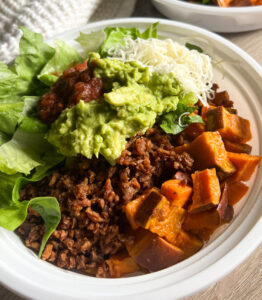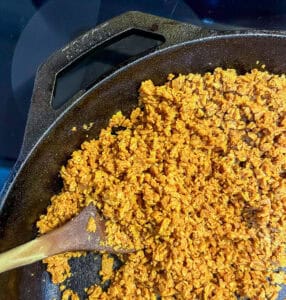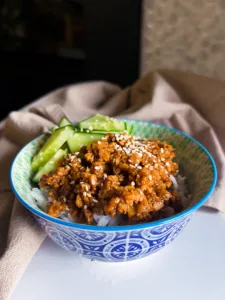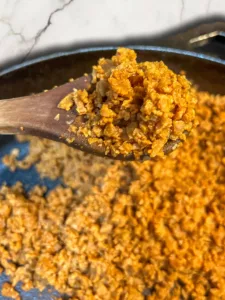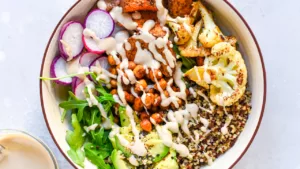Textured vegetable protein (TVP) is a versatile, high-protein meat substitute made from defatted soy flour. It comes from soy products and whole soybeans after extracting soybean oil. TVP is a dehydrated product with a long shelf life, often stored in an airtight container. It’s a generic name for a food product that is a great substitute for ground beef and other meat products. Many grocery stores and health food stores carry this highly nutritious soy product.
In this article, we will delve into the world of textured vegetable protein, exploring its definition, benefits, uses, and the differences between TVP and other plant-based protein sources.
What Is TVP?
TVP is a high-protein meat extender and meat replacement with a meat-like texture. It mimics the chewy texture and flavor of whatever recipe you prepare. Whether you’re aiming to make sloppy joes, taco meat, or even soy chicken strips, TVP offers a similar texture to ground meat. This complete protein contains all essential amino acids and is an excellent source of dietary fiber, making it a great addition to a plant-based diet and vegetarian diet.
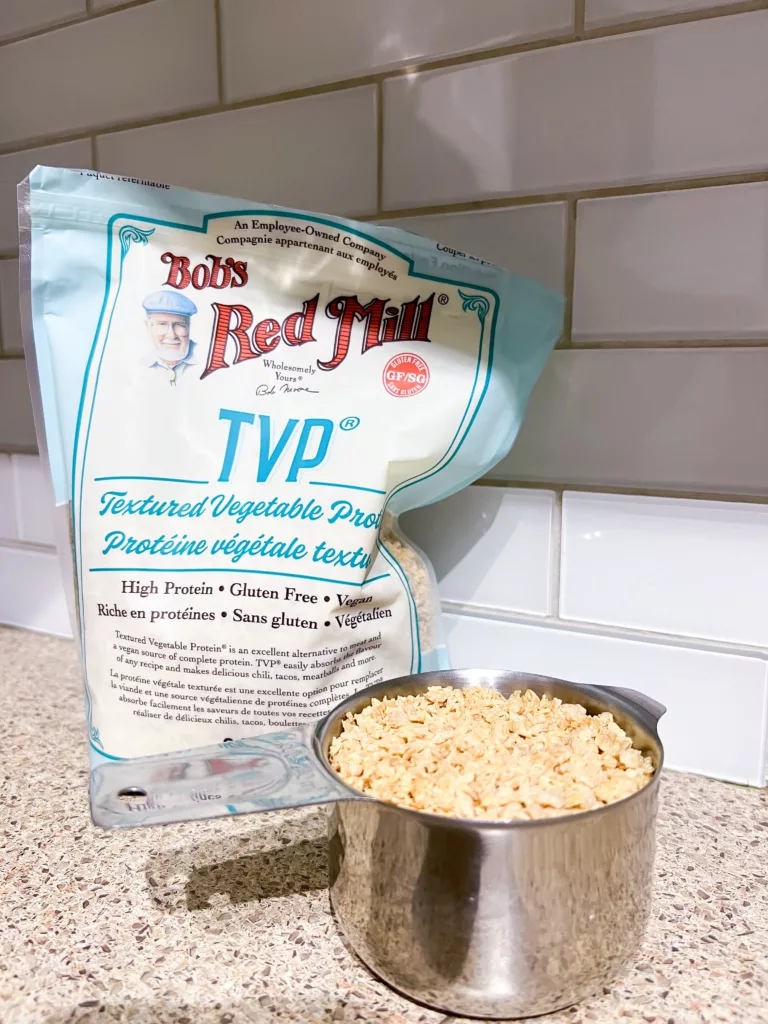
It’s produced by processing defatted soy flour from soy beans into a dry form that can be rehydrated with hot water or vegetable broth. Some forms come as tvp chunks, tvp flakes, or even large chunks, giving you unique textures to experiment with. TVP stands as a popular meat substitute with a meaty texture and is a common ingredient in many vegan recipes, including veggie burgers, soy burgers, and vegan sausages.One of my favorite brands is Bob’s Red Mill.
The Benefits of Textured Vegetable Protein
TVP offers many advantages. It has high protein content and is a complete protein, rich in essential amino acids. Its good source of dietary fiber supports healthy digestion and may help lower the risk of heart disease. TVP is affordable, has a long shelf life, and works well as a meat extender in dishes like spaghetti sauce, pasta sauces, and even sloppy joes.
This food product is not just a meat replacement; it also helps improve human nutrition. It provides much taste without extra fat or saturated fat. Plus, it’s a whole food that fits right in with plant foods on a vegetarian diet. The Agriculture Association of the United Nations even praises sustainable soy products for their benefits to the human body and heart function.
1. High Protein Content
Textured vegetable protein is a rich source of plant-based protein. With approximately 50 grams of protein per 100 grams of TVP. It provides a substantial protein boost without the saturated fats and cholesterol found in meat.
2. Healthier Fat Profile
Compared to animal-based proteins, TVP is significantly lower in fat content, particularly saturated fat. This makes it a heart-healthy choice for those looking to reduce their saturated fat intake.
3. Rich in Fiber
TVP is also an excellent source of dietary fiber. Which is essential for a healthy digestive system. Adequate fiber intake promotes regular bowel movements and aids in weight management. It helps lower the risk of chronic diseases such as heart disease and diabetes.
4. Versatility in Cooking
One of the greatest advantages of TVP is its versatility in cooking. You can use it to create meatless burgers, chili, stews, meatballs, tacos, and more. TVP’s ability to absorb flavors and mimic the texture of meat makes it a favorite ingredient among vegan and vegetarian cooks.
Watch My Video On How To Cook With TVP To Make A Ground Beef Substitute
Cooking with Textured Vegetable Protein
Cooking with textured vegetable protein is simple and convenient. Let’s break down how to cook TVP into a few easy options, so you’re ready to whip up delicious recipes like TVP taco meat, vegan meatballs, or a hearty vegan chili.
Cooking With TVP
Cooking with TVP is a simple way to add a high-protein meat substitute to your meals. The cooking process is straightforward, and there are many options to suit your needs. Let’s explore some methods:
Rehydration Options
The first step is rehydrating your cup of dry TVP. You can use hot water or vegetable broth—typically, one cup of liquid for every cup of TVP. Let it sit for 5–10 minutes. This step gives TVP a meaty texture and allows it to absorb the flavor of whatever recipe you use. For extra flavor, try adding soy sauce, a dash of defatted soy flour for extra texture, or even a splash of soy milk.
- Standard Rehydration: Add your desired amount of TVP to a bowl. Pour hot water or vegetable broth over it (use about 1 cup of liquid for every cup of TVP) and let it sit for 5-10 minutes. This step ensures the TVP absorbs the liquid and achieves a soft, meaty texture. For added flavor, use broth seasoned with nutritional yeast, black pepper, and lime juice.
- Quick Rehydration on the Stove: Place dry TVP in a large skillet over medium heat. Add hot water or broth and stir occasionally. This method is great for dishes where you’re cooking TVP directly, like stir-fries or sautéed dishes.
- For Larger Chunks or Soy Curls: If you’re working with larger chunks of TVP or soy curls, soak them in warm water or broth for 10-15 minutes. Press out excess liquid before cooking for a firmer, chewy texture.
Stove-Top Sautéing
A simple way to prepare TVP is by sautéing it. Heat a little oil in a skillet over medium-high heat. Add your rehydrated TVP and season it with spices like garlic powder, smoked paprika, and a pinch of soy sauce. Stir frequently until you see a slight browning, creating a texture similar to ground beef. This method works well for taco meat, vegan meatballs, or even as a meat extender in veggie burgers.
Simmering in Sauces
TVP is excellent when simmered in pasta sauces or spaghetti sauce. Toss your rehydrated TVP into a pot of bubbling vegetable broth or tomato sauce. Let it simmer over medium heat. This method infuses a meaty texture and flavor of beef or ground beef into the dish. It’s also a great way to incorporate TVP into recipes like chili or even soy sausages.
Baking and Grilling
For a chewy texture and a more substantial bite, mix your rehydrated TVP with breadcrumbs and spices. Form patties or balls. Bake them at high temperatures (around 375°F to 400°F) until they’re golden. Alternatively, grill them on a hot nozzle or skillet to achieve a slightly charred flavor. This technique is perfect for making soy burgers, vegan sausages, or even innovative recipes like soy chicken strips.
Other Creative Methods
You can also experiment with methods like slow cooking or using a free facility if you have a dehydrator. Whether you’re working with tvp flakes or soya chunks, each method brings out a unique texture. A cup of TVP or grams of TVP can be easily adapted into various dishes, offering a meaty texture that blends perfectly into a wide variety of dishes.
Seasoning
Once rehydrated, it’s time to season your TVP. Its neutral taste makes it a blank canvas for flavors. Add your favorite herbs, spices, or sauces. For a ground beef substitute, try mixing in smoked paprika, onion powder, garlic powder, soy sauce, and nutritional yeast for a meat-like flavor.
For sausage-flavored TVP, consider adding fennel seeds, sage, and a touch of maple syrup.
Tips for Perfect TVP Texture
- Avoid Overhydrating: Use just enough liquid to rehydrate the TVP without making it mushy.
- Squeeze Out Excess Liquid: After rehydration, press out any extra liquid to achieve the perfect texture.
- Experiment with Flavors: TVP’s adaptability means you can try different seasonings, from taco spices to Asian stir-fry sauces, for endless variety.
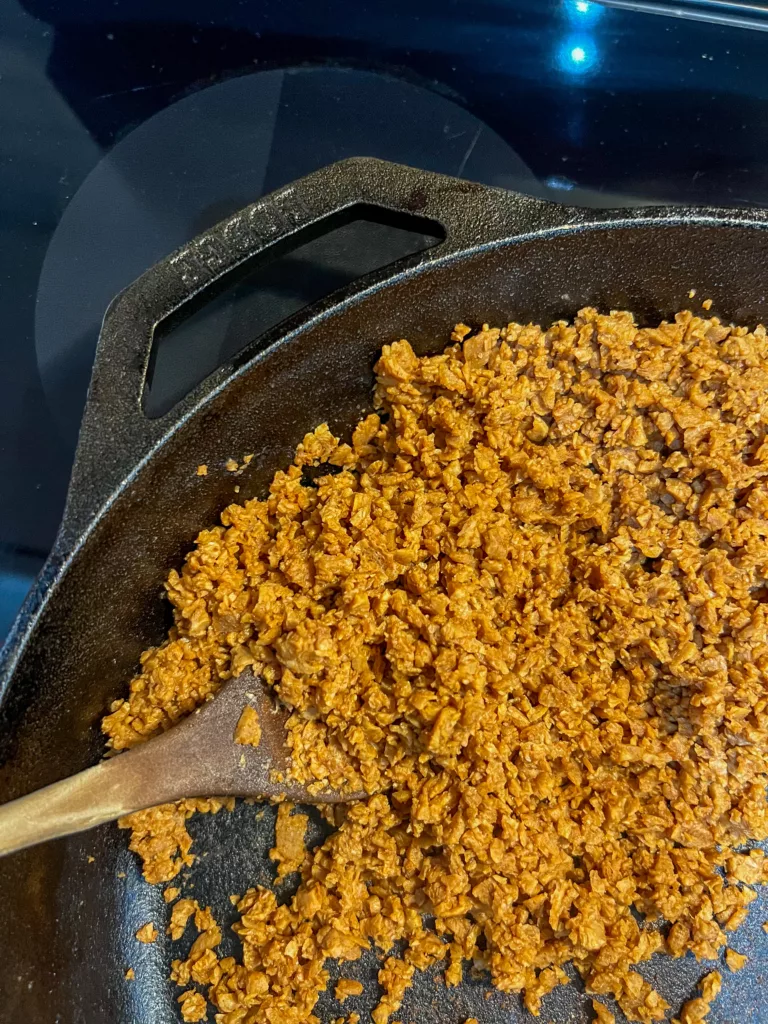

How Textured Vegetable Protein Compares to Other Plant-Based Proteins
While textured vegetable protein is a popular choice, it’s helpful to compare it with other plant-based proteins to understand its unique advantages:
- Tofu: Tofu, a soy-based protein alternative, offers a softer texture compared to TVP. Produced by curdling soy milk and pressing it into blocks, tofu offers a highly versatile texture, making it suitable for incorporation into various dishes like stir-fries, soups, and desserts. You can read our full article here on Understanding the Ingredients and What Is Tofu Made Of.
- Seitan: Seitan, also known as wheat gluten, is a protein-rich meat substitute derived from the gluten found in wheat. It acquires a chewy texture and serves as a meat substitute in dishes like stir-fries and sandwiches. You can read our full article here on What Is Seitan? Plant-Based Meat Alternative.
- Tempeh: Tempeh is a traditional Indonesian soy product that results from fermenting cooked soybeans. It has a nutty flavor and a firm texture. People commonly slice or crumble tempeh for use in stir-fries, sandwiches, and salads. You can read our full article here on What is Tempeh: The Ultimate Guide.
Each of these plant-based protein options offers unique textures and flavors. Allowing individuals to choose the option that best suits their dietary preferences and culinary needs.

The Role of Textured Vegetable Protein in a Healthy Diet
Incorporating Textured Vegetable Protein into a balanced diet can contribute to overall health and well-being. Here are some key points to consider:
- Adding TVP to your meals is a smart move. This food product is a complete protein and excellent alternative to meat products. It boosts muscle repair, supports blood cells, and promotes overall heart function. With its affordable way of providing much taste and a good source of dietary fiber, TVP fits seamlessly into both vegetarian products and vegan recipes.
- It is not only popular as a meat replacement but also acts as a meat extender in many dishes. TVP recipes can range from taco meat to veggie burgers, and even as an addition to health bars. Its versatility makes it a common ingredient in plant-based diets, offering a high-protein meat substitute that doesn’t compromise on flavor.
Recipes With Textured Vegetable Protein (TVP)
TVP Frequently Asked Questions
Individuals with soy allergies should avoid TVP. There are alternative plant-based protein sources available, such as seitan or pea protein, that can be used instead.
Yes, it is considered a complete protein source as it contains all essential amino acids required by the body.
It can be a valuable addition to a weight loss diet due to its high protein and fiber content, which can promote satiety and help control cravings.
Yes, it can be frozen for later use. Prepare and cook the TVP according to your recipe, then allow it to cool before transferring it to airtight containers or freezer bags. Freeze for up to three months.
It is available in most health food stores, grocery stores, and online retailers. It is often found in the bulk foods or vegetarian/vegan sections.
Conclusion: What Is TVP?
So, what is TVP? It’s a highly nutritious soy product with a meat-like, chewy texture that makes it a great substitute for ground beef and meat products. Whether you’re whipping up a quick stir-fry, enhancing your pasta sauces, or creating innovative vegetarian meat substitutes like soy sausages or soy burgers, TVP is a fantastic ingredient to have in your pantry.
Its ease of preparation—from rehydration with hot water or vegetable broth to creative cooking methods—ensures you have a versatile tool in your culinary kit. TVP is a unique, affordable, and high-protein option that supports a healthy plant-based diet. Enjoy exploring its wide variety of dishes, and remember, the taste of TVP will adapt to the flavor of whatever recipe you choose!
Happy cooking and enjoy the meaty texture and much flavor of TVP in your next meal!


